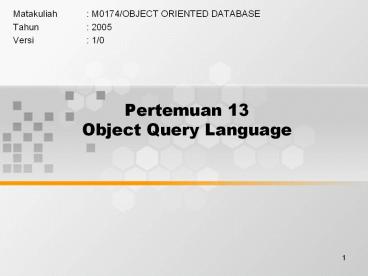Pertemuan 13 Object Query Language - PowerPoint PPT Presentation
1 / 12
Title:
Pertemuan 13 Object Query Language
Description:
Matakuliah : M0174/OBJECT ORIENTED DATABASE Tahun : 2005 Versi : 1/0 Pertemuan 13 Object Query Language Learning Outcomes Pada akhir pertemuan ini, diharapkan ... – PowerPoint PPT presentation
Number of Views:75
Avg rating:3.0/5.0
Title: Pertemuan 13 Object Query Language
1
Pertemuan 13Object Query Language
- Matakuliah M0174/OBJECT ORIENTED DATABASE
- Tahun 2005
- Versi 1/0
2
Learning Outcomes
- Pada akhir pertemuan ini, diharapkan mahasiswa
- akan mampu
- Mahasiswa dapat Menghasilkan query language dalam
object data model (C3)
3
Outline Materi
- Overview OQL
- Accessing literal and named objects
- Accessing object values
- Accessing characteristics of object
4
Overview OQL
- OQL is an object database query language, and is
specified as part of the ODMG. - OQL can also be classified as an object database
sub-language in that its scope is limited to
performing just one aspect of object database
applications, e.g the sort of queries and
manipulations that can be expressed in the object
algebra
5
Overview OQL
- A particular limitation is that OQL cant express
arbitrarily complex computations, so OQL is not
computation complete. - It is therefore necessary to use OQL in
conjunction with other computer languages - OQL is used to describe the retrieval and
manipulation of object. - The ODL define interface to object type used by
the OQL code.
6
Overview OQL
- Other programming language, such as C, Java are
used to implement object operations e.g methods - Other programming language (C,Java) are used to
implement application program, with embedded OQL
statements to manipulate the object database
7
Overview OQL
- OQL can be used for both collection-oriented and
navigational queries - A collection-oriented query retrieves a
collection of objects - The way in which those
objects are located is the responsibility of the
ODBMS, rather than the application program. - Navigational queries access individual objects
and use object relationships to navigate from one
object to another it is the responsibility of
the applications program within which the OQL is
embedded to specify the navigation procedure for
accessing all object of interest.
8
Overview OQL
- The designer of OQL have adopted an evolutionary
approach. Rather than designing a completely new
language, they have based OQL on SQL. - Many query in SQL are also valid in OQL, though
sometimes with minor change. However OQL also
extends SQL to deal with object-oriented notation
and operation invocation
9
Accessing literal and named objects
- The simplest form of OQL query is an object name.
- Object names are used as entry points into an
object database - Example
10
Accessing object values
- Dereferencing
- Example
11
Accessing characteristics of object
- An object name can be used, in conjunction with
the names of object characteristics (attributes,
relationships, and operations) to access the
individual characteristics of the named object or
of others related to it - Path
- Example
12
SUMMARY
- OQL can define objects of interest using object
names and literal values as entry points into an
object database. - The simplest form of OQL query is a name or
literal value - Paths are used to access object characteristics
and related object. - Queries can access objects
- Alternatively, by preceding a query with an
asterisk, it an access object values































